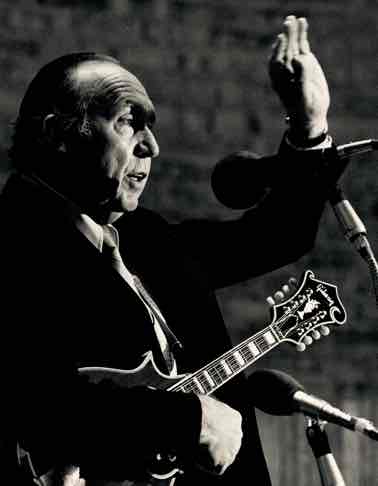
JETHRO BURNS
During the course of a career that lasted more than 50 years, the late Kenneth “Jethro” Burns was given many nicknames and accolades. Mandolin players called him “The Legend,” “The Great One,” “Mr. Mandolin” and the “World’s Greatest Mandolin Player.”
Certainly he was a major influence on many of today’s leading players. His ever evolving style, a blend of clean single note lines, sophisticated harmonies, and ground-breaking chord melody arrangements for solo mandolin, emphasized the melody and loose swinging rhythm.
Born in rural north Georgia on March 10, 1920, Jethro and his folks moved to Knoxville Tennessee when he was 3. His brothers all played music and they got plenty of support and understanding from their father, who worked on the medicine show circuit as a tap dancer and comedian. It was from his father that he got a firsthand view of music and comedy together. Jethro later credited him saying, “Because of him, I always had a good understanding of exactly what I was doing as an entertainer.”
As anyone who ever saw Jethro perform will attest, he had very good understanding indeed. His wacky cornball humor was always “note perfect,” and his Mandolin playing was as entertaining as it was soulful.
For 39 of those 50 years in show business, Burns performed with Henry Haynes as the musical comedy duo known worldwide as “Homer & Jethro.” Their collaboration yielded 35 albums, a Grammy award, regular appearances on national television and radio shows such as Johnny Carson, Dean Martin and Jimmy Dean. A series of outrageously successful, and just plain outrageous commercials for Kellogg’s Corn Flakes.
Most of their comedy songs were Jethro’s parodies of hit pop and country tunes. Their brilliance as comedians threaten to overshadow their virtuosic musicianship, although two instrumental albums displayed their pioneering string jazz sound.
Henry Haynes died suddenly in 1971, but that painful loss didn’t thwart Jethroís musical evolution. He began teaching and teaming with Chicagoan Ken Edison for three Mandolin instruction books published by Mel Bay. The two of them also performed regularly as “Homer & Jethro.”
Once Burns met singer-songwriter Steve Goodman at a Chicago folk club, another legendary mandolin and guitar duet began. Their tours, and Goodman’s albums, introduced Jethro to a new generation of fans.
In later years, Jethro appeared regularly on the television program “Hee Haw.” He also played with his brother-in-law Chet Atkins and the “Million-Dollar Band,” and returned to his live radio roots on a “Prairie Home Companion.” He wrote a regular monthly column for the publication “Mandolin World News,” and performed club dates with his “Jethro Burns Quartet,” which included two mandolin’s, a guitar, and a bass. The members included rhythm guitarist John Parrott, bassist Neil Seroka, and Don Stiernberg on mandolin.
Steve Goodman once said of Jethro, “I never heard him play or say anything that wasn’t the very thing that everyone else in the room wished they had played or said.” How did he do it? His special skill was to mix equal parts mischief and genius. (While keeping his tongue firmly in cheek at all times!). A large part of his appeal can be summed up in his philosophy of “No matter where you go, there you are!”<